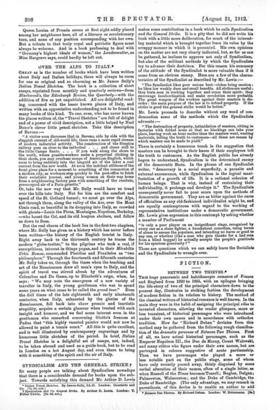OVER THE .ALPS TO ITALY.• GREAT as is the number
of books which have been written about Italy and Italian holidays, there will always be room for one so original and so charming as Mr. James Sully's Italian Travel Sketches. The book is a collection of short essays, reprinted from monthly and quarterly reviews—from Blackwood's, the Edinburgh Review, the Quarterly—with the addition of five as yet unpublished. All are delightful read- ing, concerned with the lesser known places of Italy, and written with an appreciative understanding not to be found in many books of this kind. To one, even, who has never known the places written of, the " Travel Sketches " are full of delight and of a power of vivid description, not a little helped by Noel Boxer's clever little pencil sketches. Take this description of Baveno
"A visitor soon discovers that in Baveno, side by side with the sluggish current of old-world life, there runs a more rapid stream of modern industrial activity. The construction of the Simplon railway goes on close to the cathedral . . . and closer still to the little Campo Santo. . . If you walk along the shore to the north, where granite-workers make a perpetual clicking in their sheds, you may overhear scraps of American-English, which seem to bring suddenly into the languid air of the lakes a cool current from the new world. At noon the indolent stillness of the front gives place for a moment to something of the commotion of a modern city, as workmen step quickly to the post-office to fetch their socialistic journal, and young women on their way home from a neighbouring factory pass with something of the resolute, preoccupied air of a Paris grisette."
Or, take the new way that Mr. Sully would have us tread over the hills into Italy. Not for him are the comfort and
speed of the St. Gothard tunnel ; we must go over the Alps, not through them, along the valley of the Arc, over the Mont Cenis road, so beautiful in its dropping into Italy, so crowded with ghosts—Louis the Pious, Montaigne, Napoleon, Berkeley, —who haunt the Col, and its old hospice shelters, and follow us down to Suss.
But the real charm of the book lies in the first two chapters, where Mr. Sully has given us a history which has never before been written—the history of the English tourist in Italy. Right away back to the thirteenth century he traces the modern " globe-trotter," to the pilgrims who took a real, if surreptitious, interest in things pagan, and in their Mirabilia Urbis Rornae, commended Pheidias and Praxiteles as " two philosophers." Through the fourteenth and fifteenth centuries Mr. Sully takes us, through the times when the teaching and art of the Renaissance drew all men's eyes to Italy, and the spirit of travel was stirred afresh by the adventures of Columbus and Da Gama, up to Elizabeth's reign, when, he says : " We may note the emergence of a new variety of traveller in Italy, the young gentleman who was to spend some years on what came to be called the grand tour." Even the dull times of the late eighteenth and early nineteenth centuries, when Italy, exhausted by the glories of the Renaissance, fell back into sheer prosaic and inartistic
stupidity, acquire a certain glamour when treated with such insight and humour, and we feel some interest even in the gentleman who remarked concerning G lotto's frescoes at Padua that "this highly vaunted painter would not now be allowed to paint a tennis court." All this is quite excellent, and is well illustrated by contemporary engravings and by humorous little sketches of the period. In brief, Italian Travel Sketches is a delightful set of essays, not, indeed,
to be taken abroad and used as a guide-book, but to be read in London on a hot August day, and even there to bring with it something of the spirit and the air of Italy.


































 Previous page
Previous page